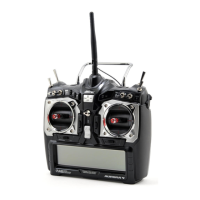
Do you have a question about the HITEC Aurora 9 and is the answer not in the manual?
| Channels | 9 |
|---|---|
| Frequency | 2.4GHz |
| Modulation | AFHSS (Adaptive Frequency Hopping Spread Spectrum) |
| Telemetry | Yes |
| RF Power | 100mW |
| Display | LCD |
| Power Supply | LiPo or NiMH |
| Model Memory | 30 Models |
Details on battery options (NiMH, Li-Po) and charging.
Information on obtaining programming help through various channels.
Contact information and hours for Hitec customer support.
Critical safety suggestions for flying models safely.
Instructions for charging the supplied NiMH battery pack.
Information and warnings about using a 2S Li-Po transmitter battery.
Details on features of Optima 2.4GHz receivers for a satisfying R/C experience.
Features of the SPECTRA 2.4GHz module for trouble-free 2.4GHz signal.
Instructions for setting up and using the Hitec 2.4GHz system with Optima receivers.
Features of Optima 2.4GHz receivers compatible with SPECTRA 2.4GHz module.
Information on setting up and using the FAIL-SAFE function for safety.
Selecting between Normal and Scan operational signal types.
Programming FAIL-SAFE points for receiver signal interruption.
Guide to setting up system menus for helicopters.
Guide to setting up model menus for helicopters.
Menu option to create or select a new model, copy data, or reset defaults.
Menu to select the signal modulation type: 2.4, 72 FM, or QPCM.
Selects the active model's transmit channel for PPM and QPCM.
Guide on how to select a switch for a specific function.
Setting up switches using the Adjust function.
End Point Adjustment for servo travel limits.
Dual Rates and Exponential settings for control response.
Servo Sub-trim adjustment for centering servos.
Servo reversing function to change direction.
Programmable Mixing for advanced control setups.
Servo position FailSafe settings.
Functions specific to ACRO and GLID models.
Idle-up and hold / Flight Conditions setup.
Pitch curve & Throttle curve adjustment.
Throttle hold function.
Gyro functions.
Recommendations to start with quick start guides for initial programming experience.
Explanation of the Aurora's open software architecture allowing flexible control assignments.
Warnings during system boot-up, such as high throttle or condition settings.
Guidance for handling continuous beeping during flight.
Warning for critically low transmitter battery power.
Warning for low aircraft battery when using SPECTRA 2.4 Module.
Explanation of Normal and Scan modes for 2.4GHz operation.
Step-by-step guide for setting up the FAIL-SAFE function.
Ensuring all servos and control surfaces are working properly before flight.
Details on Normal Mode operation and its advantages.
Procedure to test the configured FAIL-SAFE settings.
Details on low battery warnings for NiMH, Nicad, and Li-Po packs.
Importance of performing a range check before each flying session.
Details on Scan Mode operation and its advantages.
Steps to deactivate FAIL-SAFE and reactivate Hold Mode.
Importance of range checking and method for 2.4GHz systems.
Procedure for binding or linking Optima receivers to the transmitter.
Steps for binding in Normal Mode.
Procedure for using the power-down mode for range checking.
Steps for binding in Scan Mode.
Explanation of FAIL-SAFE and Hold Mode functions.
